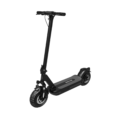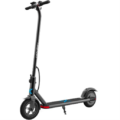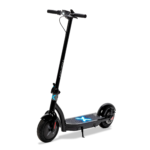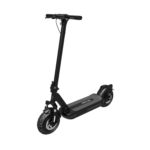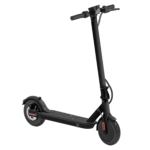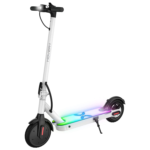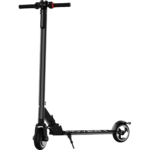- Home
- Scooters
- Electric Scooters
- Hover-1 Boss R800
Hover-1 Boss R800
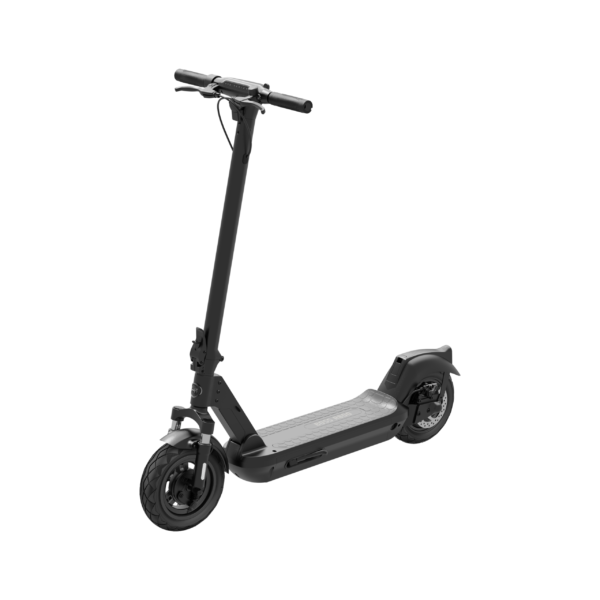

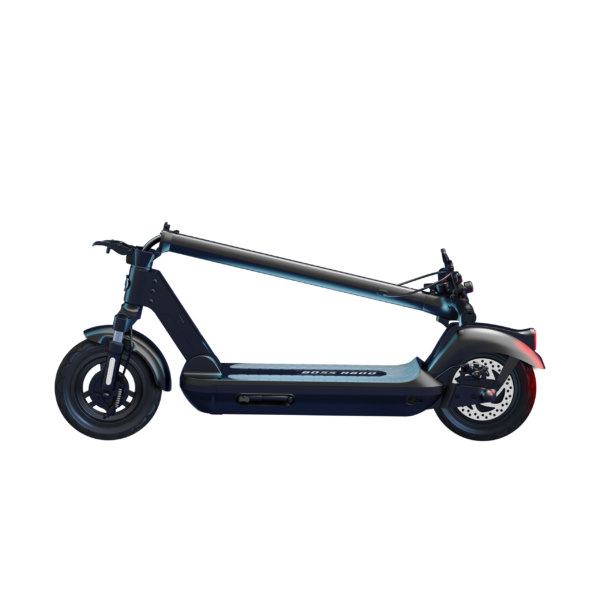

- Battery Range: 28 miles (45 km)
- Top Speed: 24 mph (39 km/h)
- Motor Power: 800 W (rated)
- Weight Capacity: 264 lb (120 kg)
- Charging Time: 5.5 hours
- Scooter Weight: 46.9 lb (21.3 kg)
PROS
- 48V 13Ah battery
- 24 mph (39 km/h) top speed
- Front & rear suspension
- 10″ × 2.75″ tubeless tires
- Front drum + rear disc + electronic brakes
CONS
- IP rating not specified
- 46.9 lb (21.3 kg) weight
- Folded size still bulky
- Charge time ~5.5 hours
Table of contents
- What Is the Hover-1 Boss R800?
- How the Hover-1 Boss R800 Works
- Key Specifications
- Design & Build Quality
- Performance Fundamentals
- Battery, Range & Efficiency
- Ride Quality & Comfort
- Braking & Safety Features
- Portability & Daily Usability
- Maintenance & Care
- Weather & Seasonal Considerations
- Hover-1 Boss R800 vs Alternatives
- Who the Hover-1 Boss R800 Is (and Isn’t) For
- FAQs
- Glossary
- Final Thoughts
The Hover-1 Boss R800 is a higher-powered, app-connected electric scooter built for riders who want confident speed and cushioned comfort without jumping to a heavy, dual-motor machine. It pairs an 800W brushless rear hub motor with dual suspension and 10-inch self-sealing tubeless tires. As a result, it suits daily commuters, students, and weekend riders who value stability, range, and simple upkeep more than raw, race-style acceleration.
Because it uses a 48V, 13Ah battery and a reinforced frame, the Boss R800 feels planted at speed and composed over rough patches. Yet it still folds quickly and fits into car trunks, closets, or office corners. If you want a practical step up from entry-level scooters, this model lands right in that sweet spot.
What Is the Hover-1 Boss R800?
In short, it is a single-motor, 800W rear-drive scooter with a top speed rated up to 24 mph (38.6 km/h) and an estimated range up to 28 miles (45 km) under favorable conditions. The chassis features dual front shocks plus dual rear springs, which smooths out typical city blemishes like expansion joints, trolley tracks, and patched asphalt. Meanwhile, 10″ self-sealing tubeless tires add puncture resilience and easy air maintenance.
The deck is long and stable, the stem locks into a straightforward folding latch, and the cockpit is clean: a center LED display, thumb throttle, and familiar levers. Finally, the H-1 Pro Series mobile app gives you remote lock/unlock, basic tracking, ride metrics, and speed-mode control. Because everything is integrated, you don’t need extra gadgets to log miles or tweak settings.
How the Hover-1 Boss R800 Works
Think of the R800 like a compact, electric moped without a seat. The rear hub motor is the engine. It draws power from a 48V lithium-ion pack (13Ah) and sends torque straight to the wheel. Therefore, there are no chains, belts, or external gears to tune. The controller is the brain. It meters current to the motor based on your thumb-throttle input and your selected speed mode (Sport, Drive, Eco, or Walk).
When you squeeze the brake levers, three systems respond. The front uses a drum brake, the rear uses a disc brake, and the motor assists with electronic braking. Together they deliver firm, predictable stops. An onboard LED display shows speed, battery, mode, lock status, and other icons such as cruise control and kick-to-start. The lights, reflectors, and safety interlocks round out the package. Because the design is modular, routine service is simple: keep fasteners tight, tires inflated, and brakes adjusted.
Key Specifications
Below are the official specifications presented in easy blocks. US units appear first, with metric in parentheses.
General
| Item | Detail |
|---|---|
| Model | H1-BSS-R8 |
| Product Weight | 49.82 lb (22.6 kg) |
| Max Supported Weight | 264 lb (120 kg) |
| Minimum Supported Weight | 40 lb (18 kg) |
| Recommended Rider Age | 16+ |
Performance & Power
| Item | Detail |
|---|---|
| Rated Motor Power | 800W (rear hub) |
| Max Motor Power | 1,100W (peak) |
| Top Speed | Up to 24 mph (38.6 km/h) |
| Max Range | Up to 28 miles (45 km) |
| Max Incline | 15° |
| Speed Modes | Sport, Drive, Eco, Walk |
Battery, Charging & Electrical
| Item | Detail |
|---|---|
| Battery Type | Lithium-ion |
| Battery Voltage | 48V nominal (pack section lists 46.8 Vdc) |
| Battery Capacity | 13Ah (≈624 Wh nominal) |
| Charger Output | 54.6V / 3A |
| Charge Time | Up to 5.5 hours |
| Power Requirement | 100–240V AC, 50/60 Hz |
| Display | Center LED matrix (mph/km/h, modes, cruise, lock, trip/odo, indicators) |
| App | H-1 Pro Series (lock/unlock, location features, modes, ride metrics) |
Build & Dimensions
| Item | Detail |
|---|---|
| Tires | 10″ × 2.75″ self-sealing tubeless (front & rear) |
| Suspension | Dual front shocks + dual rear springs |
| Unfolded Size | 44.6 × 20.4 × 45.9 in (113.3 × 51.8 × 116.6 cm) |
| Folded Size | 44.6 × 20.4 × 8.2 in (113.3 × 51.8 × 20.8 cm) |
| Frame | Alloy stem and deck with integrated fenders |
Safety & Control
| Item | Detail |
|---|---|
| Brakes | Front drum + rear disc + electronic brake |
| Lights | Headlight and taillight; reflectors |
| Start Behavior | Kick-to-start |
| Display Alerts | Error codes, speed mode, cruise indicator |
Features & Extras
| Item | Detail |
|---|---|
| Cruise Control | Yes |
| Mobile App Features | Remote lock, speed-mode management, ride data, basic location functions |
| Walk Mode | 0–3 mph (0–5 km/h) for crowded areas |
| Eco Mode | 0–15 mph (0–24 km/h) for range focus |
| Drive Mode | 0–20 mph (0–32 km/h), balanced |
| Sport Mode | 0–24 mph (0–38.6 km/h), performance |
Warranty & Compliance
| Item | Detail |
|---|---|
| Warranty | 1-year limited parts & labor (manufacturer terms apply) |
| FCC ID | 2AANZBSSR8 |
| Bluetooth ID | D061001 |
Design & Build Quality
The Boss R800 presents a compact, muscular stance. The stem is a straight, box-section design that feels solid under normal urban use. Because the folding latch lands low, the deck stays unobstructed and comfortable for long stances. The latch itself has a metal safety catch that you must seat firmly; once closed, the hinge feels secure and creak-free.
On deck, the rubberized surface adds grip without harsh texture. The wheelbase and deck length give your rear foot plenty of room. Consequently, you can rotate your feet to relieve pressure during long commutes. Cable routing is tidy; most lines run internally or close to the frame. The mudguards are rigid enough to resist flap at speed, and the rear unit protects the brake rotor from casual bumps.
Up front, dual shocks take the sting out of pothole edges. In back, dual springs help the rear stay composed over ripples and driveway lips. The system is tuned for everyday comfort rather than aggressive off-road use. With 10″ tubeless tires, the scooter rolls over cracks more smoothly than 8.5″ commuter models. Furthermore, because the tires are self-sealing, small punctures often plug themselves, which reduces flats and stress.
The cockpit is straightforward. A bright LED display sits center-top. You can toggle modes, view trip and odometer, and see icons for cruise, lock, and Bluetooth. Lever feel is firm and predictable. The thumb throttle has a short but controllable throw, so low-speed maneuvering in parking lots and bike lanes feels natural.
Performance Fundamentals
Acceleration feel. In Sport mode, the R800 steps off briskly once you nudge the throttle past its initial dead zone. It does not launch like a dual-motor scooter; however, it pulls cleanly through the midrange. Around 10–18 mph, the motor’s torque curve makes casual overtakes effortless. Because the controller meters power smoothly, you can feather the throttle in traffic without surging.
Cruising stability. The long deck and 10″ tires keep the chassis stable at neighborhood speeds. As velocity increases, the front end remains calm, helped by the dual shocks and the stiff stem. Grip improves if you keep the tires at their recommended pressure and ride with a soft bend in your knees. On fresh asphalt, the scooter holds a line without drama.
Hill-climb behavior. On moderate hills around 7% grade, expect the R800 to maintain useful commuter speeds if you enter with a little momentum. On steeper grades near 10%, the scooter will slow. That is normal for a single 800W motor and a 48V pack. If you start a climb from a dead stop, give one or two strong kick-starts. Then keep a steady throttle. Additionally, selecting Sport mode before the incline helps the controller deliver peak current earlier.
Battery, Range & Efficiency
Pack and chemistry. The Boss R800 runs a 48V lithium-ion pack rated at 13Ah. In marketing terms this is “48V”; in engineering terms the pack section lists 46.8 Vdc nominal, which matches a 13-series cell arrangement. The two numbers describe the same battery family from different angles. This is common across electric scooters.
Rated vs real-world range. The headline figure is up to 28 miles (45 km). Real-world range varies. Rider mass, wind, hills, temperature, and speed mode all matter. With a 264 lb (120 kg) limit and a 49.82 lb (22.6 kg) chassis, heavier riders will draw more watt-hours per mile. Cold weather also reduces capacity. Meanwhile, riding in Drive or Eco mode at steady speeds dramatically stretches miles per charge.
Practical expectations. On flat routes with a 150–180 lb rider, a balanced pace in Drive mode often covers long commutes comfortably. Add headwinds, hills, or frequent stop-and-go, and you should plan a shorter loop or a midday top-up. Because the charger outputs 54.6V/3A, a near-empty pack returns to full in roughly 5.5 hours.
Charging best practices. First, let the pack settle to room temperature before charging, especially after a cold ride. Second, keep the charge port clean and dry. Third, avoid leaving the charger attached days at a time. Finally, if you store the scooter for weeks, charge to around mid-level and top up monthly. These habits preserve long-term health and keep your specifications-level performance closer to new.
Ride Quality & Comfort
The comfort story starts with tires. Because the R800 uses 10″ self-sealing tubeless tires, you get the pliancy of pneumatic rubber plus the convenience of built-in sealant. Small punctures may hiss, seal, and stop, allowing you to finish the ride. Also, the 2.75″ width offers a larger contact patch than narrow commuter rubber. Consequently, the scooter feels planted through small bends and across patched surfaces.
Next comes suspension. Dual front shocks and dual rear springs are tuned on the softer side. They soak up sidewalk seams and brickwork edges, and they reduce the buzz that makes hands tired. Still, they are not designed for jumps or aggressive trail riding. You will enjoy the ride most on paved bike lanes, boulevards, and smooth park paths.
Ergonomics remain friendly. The deck height leaves ample ankle clearance. The handlebars sit at a natural reach for average riders. Tall riders can stagger feet diagonally and keep a slight bend in elbows for better control. Meanwhile, the stem resists flex at practical speeds. If you feel micro-wobble on rougher asphalt, widen your stance and bend your knees. Those two adjustments usually calm the chassis immediately.
Braking & Safety Features
The system combines three layers: a front drum, a rear disc, and electronic braking through the motor. Drum brakes excel in wet spray and require little adjustment. Disc brakes add bite and better heat shedding. Electronic braking finishes the job and reduces pad wear. Together, they deliver short, predictable stops when you squeeze both levers progressively.
Lighting covers the basics. The headlight throws forward illumination so others see you, while the taillight increases rear visibility. Reflectors add passive safety at night. Additionally, the LED display shows clear mode icons and battery status, so you can verify settings at a glance before rolling off.
Water exposure deserves a note. The manual advises keeping the scooter away from water, puddles, and heavy rain. Therefore, treat the R800 as a fair-weather ride. If you encounter wet patches, slow down gently, avoid mid-corner braking, and use extra space for stopping. Traction on painted lines and metal covers drops sharply when wet.
Portability & Daily Usability
Even with a reinforced frame, the Boss R800 folds in seconds. Press the hinge release, swing the latch, and rest the stem on the rear hook. Because the folded height is only 8.2 inches (20.8 cm), it slides under desks, into trunks, and behind apartment doors. Carrying 49.82 lb (22.6 kg) takes two hands on stairs, but rolling is easy thanks to the large wheels.
In practice, daily habits separate a good commute from a frustrating one. Lock your scooter securely when stored in public areas. The app’s remote lock adds convenience; however, it’s not a substitute for a sturdy physical lock. At the office, wipe the deck dry before carrying it through lobbies. At home, charge on a hard, non-carpeted surface with good airflow.
Speed modes help match your context. Eco extends range for meandering city errands. Drive balances pace and efficiency. Sport suits open paths and time-sensitive commutes. Walk mode lets you roll beside pedestrians without riding. Because the modes are predictable, you can set one and forget it for weeks if your route rarely changes.
Maintenance & Care
A little attention goes a long way. Use this simple rhythm:
- Before rides (weekly if you ride daily). Check tires for cuts, embedded debris, and pressure per the sidewall. Squeeze both brake levers; adjust if the bite point feels too far or too close. Verify the latch is fully seated and the safety catch is engaged. Confirm lights and the display function.
- Every 2–4 weeks. Inspect rotor and drum response for consistent braking feel. Tighten stem clamp bolts, brake caliper bolts, and fender screws to sensible torque. Spin wheels to ensure there is no scraping from misaligned calipers. Clean the deck and wipe cables.
- Every few months. Refresh tire sealant if you ride frequently and notice more frequent punctures. Check pads for wear. Re-grease the folding hinge lightly if it starts to creak (avoid contaminating braking surfaces). Update the H-1 Pro Series app and firmware when available.
- Battery care. Keep charging sessions within normal room temperatures (32–104°F / 0–40°C recommended). Do not charge in direct sun. If storing for winter, leave the pack around half full and top off monthly. Because lithium-ion dislikes extreme heat or cold, a temperate garage or closet is ideal.
Weather & Seasonal Considerations
Cold. As temperatures drop, internal resistance rises and usable capacity falls. Therefore, range shrinks in winter. Keep the scooter and charger inside before use, and start rides with a warm battery. After cold commuting, let the pack warm to room temperature before charging.
Heat. High heat stresses the pack and reduces long-term health. Park in shade when possible. Avoid charging immediately after a scorching ride; let the pack cool down first.
Rain. The manufacturer warns against puddles, heavy rain, and water immersion. Plan alternate routes in stormy seasons, and slow down when you must cross damp patches. Additionally, keep the charge port cap clean and sealed.
Storage. If you pause riding for weeks, clean the scooter, charge to mid-level, and store in a dry, ventilated area. Do not stack items on the deck or bars; pressure can tweak alignment.
Hover-1 Boss R800 vs Alternatives
This scooter sits between common commuter models and full-blown performance machines.
- Versus entry-level commuters (350–500W). The R800 accelerates harder, holds speed better on gentle climbs, and rides smoother over rough pavement. It also carries heavier riders more comfortably. However, it weighs more and costs more, and it’s overkill for very short, flat hops.
- Versus performance commuters (single 800–1000W class). The R800 lands squarely here. It offers modern app features, self-sealing tubeless tires, and dual suspension at a reasonable weight. Some competitors may add hydraulic discs or slightly larger batteries, yet many skip self-sealing rubber or app-based locking. Trade-offs come down to braking feel, deck size, and small feature preferences.
- Versus dual-motor machines. Those are quicker on steep hills and in short sprints. However, they are heavier, harder to carry, and often more demanding to maintain. If you don’t need blistering acceleration, the R800’s simplicity and balance can be a smarter everyday choice.
In practice, the R800 excels for urban riders who want stability, range headroom, and minimal fuss. If your route includes long flats, occasional small hills, and rough patches, it makes a lot of sense.
If you’re weighing a lighter, lower-power option from the same family, consider the Hover-1 Boss R500 for calmer pacing and similar commuter ergonomics.
Who the Hover-1 Boss R800 Is (and Isn’t) For
Ideal for:
- Commuters riding 5–12 miles each way who want a smooth, stable chassis.
- Students and campus riders who value app lock, tracking features, and easy folding.
- Multi-modal travelers who carry a scooter in a trunk or on transit, yet still want strong pace.
- Bigger riders who sit near the top of typical scooter weight limits; the R800 supports up to 264 lb (120 kg).
Not ideal for:
- Frequent riders in heavy rain or on muddy paths; the brand discourages water exposure.
- Steep-hill dwellers who require brisk climbs on grades above 10%.
- Those who need ultra-light portability; at nearly 50 lb, it is steady rather than featherweight.
FAQs
1) How fast does it go, and is that speed practical?
It’s rated up to 24 mph (38.6 km/h). On clear paths, Sport mode reaches that speed quickly enough for commuting. However, traffic and local rules may dictate lower speeds day-to-day.
2) What real-world range should I expect?
The claim is up to 28 miles (45 km). In mixed city riding, expect less. Weight, hills, temperature, and pace all matter. Drive and Eco modes extend range noticeably.
3) Does the R800 have cruise control?
Yes. Cruise control engages to maintain a steady pace on long, straight sections. Always stay alert and cover your brakes while using it.
4) What tire type does it use, and why does that matter?
It uses 10″ self-sealing tubeless tires. They are pneumatic for comfort, and built-in sealant helps plug small punctures automatically. Consequently, flats are less frequent and easier to manage.
5) Can I ride it in the rain?
The manufacturer advises keeping the scooter away from puddles and heavy rain. Therefore, treat it as a fair-weather vehicle and slow down on damp surfaces.
6) What’s included with the purchase?
You get the scooter, a wall charger, and the owner’s manual. You add the mobile app yourself for locking, modes, and ride data.
7) Where can I find a “Hover-1 Boss R800 overview” in one place?
You’re reading it. This guide consolidates the essentials: design, battery, ride feel, maintenance, and safety.
Glossary
- Ah (Amp-hours): Battery capacity measure. Higher Ah often means more range.
- Wh (Watt-hours): Energy measure (Voltage × Amp-hours). It estimates usable miles more directly than volts alone.
- Controller: The electronic module that regulates power from the battery to the motor.
- Brushless Hub Motor: A compact motor built into the wheel; efficient and low-maintenance.
- Regen (Electronic Braking): Motor-based braking that slows the wheel and reduces pad wear.
- Stem Flex: Slight front-end movement under load; too much can feel wobbly.
- Kick-to-Start: Safety behavior requiring a short push before the motor engages.
- Cruise Control: A function that holds a steady speed until you brake or adjust the throttle.
- Tubeless Tire: A pneumatic tire without an inner tube; it seals against the rim and can self-seal small holes with sealant.
- IP Rating: A water- and dust-ingress code. If unspecified, avoid water exposure.
- Disc Brake: A caliper squeezes pads onto a metal rotor for strong stopping.
- Drum Brake: A sealed brake inside the wheel hub; consistent in wet conditions, low maintenance.
- Speed Modes: Preset power and speed limits (e.g., Eco/Drive/Sport/Walk).
- Odometer (Odo): Total recorded distance.
- Peak Power: Short bursts above rated motor power for acceleration.
Final Thoughts
The Hover-1 Boss R800 blends meaningful power with everyday comfort and approachable maintenance. It rides smoother than small-wheel commuters, yet it remains practical to fold and store. The app adds modern convenience, while the triple-layer braking system inspires confidence. If you want a solid step up that stays friendly and dependable, this scooter earns a long look.
Specifications
General
| Model The Model specifies the exact version or name of the scooter. It helps identify its unique design, features, and specifications within the manufacturer’s product line. Knowing the model makes it easier to compare options, find compatible accessories, or look up support information. | Boss R800 |
| Brand The Brand identifies the manufacturer or company that designs and produces the scooter. A trusted brand is a sign of quality, reliability, and good customer support. Well-known brands often have higher standards for safety, performance, and after-sales service, giving you more confidence in your purchase. | Hover-1 |
| Release Date The Release Date indicates when the scooter model was officially launched on the market. This helps you know how current the design, technology, and features are. A newer release date often means updated components, improved performance, and the latest safety or smart features. | 17 November 2025 |
| Recommended Age Recommended Age indicates the minimum age range that the scooter is designed for, based on safety, size, and ease of use. Following the recommended age helps ensure that riders can handle the scooter’s speed, weight, and controls comfortably and safely. Always check local laws and use protective gear, especially for younger riders. | 14+ |
Performance & Power
| Motor Power (Wattage) What it means: The motor power, measured in watts (W), shows how strong the scooter’s electric motor is. Why it matters: Higher wattage usually means better acceleration, more torque, and improved performance on hills or rough terrain. For example, a 250W motor is good for flat city roads and light riders, while a 500W or 1000W motor provides more power for faster speeds or climbing steep inclines. | 800 W (rated), 1,100 W (max); Rear, single motor |
| Top Speed The Top Speed indicates the maximum speed that the scooter can reach under optimal conditions. It’s usually measured on level ground with a fully charged battery and an average rider weight. A higher top speed allows you to travel longer distances faster, but always ensure you ride within legal speed limits and your personal comfort zone for safety. | 24 mph (39 km/h) |
| Battery Capacity Battery Capacity refers to the total amount of energy the scooter’s battery can store, usually measured in ampere-hours (Ah) or watt-hours (Wh). A higher battery capacity means you can ride longer distances on a single charge, reducing the need for frequent recharging. Keep in mind that actual range can vary depending on rider weight, terrain, speed, and weather conditions. | 48 V 13 Ah (624 Wh) |
| Estimated Range per Charge The Estimated Range per Charge indicates the average distance the scooter can travel on a single full battery charge. This range is calculated under optimal conditions, such as flat terrain, moderate speed, and average rider weight. Real-world range may vary depending on riding style, terrain, weather, and load. A longer range means fewer recharges and greater freedom for longer trips. | Up to 28 miles (45 km) |
| Hill Climb Ability Hill Climb Ability describes the maximum incline or slope that the scooter can handle while maintaining stable performance. It’s typically expressed as a percentage or in degrees. A higher hill climb rating means the scooter can tackle steeper hills without losing too much speed or power. Actual climbing performance may vary based on rider weight, battery charge, and terrain conditions. | Up to 17% / 15° |
| Drive System The Drive System refers to how power from the motor is delivered to the wheels. Electric scooters typically use either a hub motor (directly integrated into the wheel) or a chain/belt drive system. A high-quality drive system ensures smooth acceleration, efficient power transfer, and low maintenance. The choice of drive system affects performance, noise level, and overall ride experience. | Rear hub (RWD) |
Charging & Electrical
| Charging Time Charging Time indicates how long it takes to fully recharge the scooter’s battery from empty to 100% using the standard charger provided. Faster charging means less downtime and more time on the road. Actual charging time may vary slightly depending on battery capacity, charger output, and environmental conditions. | Up to 5.5 hours |
| Battery Type Battery Type refers to the specific technology used in the scooter’s battery, which affects performance, lifespan, weight, and charging time. Most modern electric scooters use high-quality lithium-ion (Li-ion) batteries because they offer a good balance of energy density, durability, and low maintenance. A reliable battery type ensures consistent power delivery and longer riding ranges. | Lithium-ion |
| Removable Battery A Removable Battery means the battery pack can be easily detached from the scooter for convenient charging and replacement. This feature allows you to charge the battery separately, swap it with a spare for extended range, or securely store it indoors in extreme weather. Removable batteries add flexibility and make it easier to keep your scooter powered up wherever you are. | Non-removable internal battery |
| Regenerative Braking Regenerative Braking is an energy-saving feature that converts some of the energy normally lost during braking back into battery power. When you slow down or brake, the motor works in reverse to generate electricity, which helps extend the scooter’s range and improves overall efficiency. This system also reduces wear on traditional brake components, leading to lower maintenance over time. | Not specified |
| Lighting Lighting refers to the built-in front and rear lights that enhance visibility and safety when riding in low-light conditions or at night. Good lighting helps you see the road ahead and ensures that other road users can see you. Many scooters include LED headlights, taillights, and sometimes brake lights or side reflectors for added safety and compliance with local traffic regulations. | Front LED headlight, rear LED taillight |
Build & Dimensions
| Scooter Weight Scooter Weight refers to the total weight of the scooter when fully assembled, including the battery. This affects how easy it is to carry, lift, and store the scooter when not in use. A lighter scooter is more portable and convenient for commuting, especially if you need to carry it upstairs or onto public transport. Keep in mind that a sturdy frame and quality components may add to the weight but also contribute to better durability and ride stability. | 46.9 lb (21.3 kg) |
| Maximum Rider Weight Maximum Rider Weight indicates the highest rider weight that the scooter is designed to safely support while maintaining optimal performance and stability. Staying within this limit helps ensure reliable acceleration, braking, and climbing ability, and it protects the frame, suspension, and motor from excessive strain. Exceeding the recommended limit may reduce performance and increase wear on components. | 264 lb (120 kg) |
| Deck Size Deck Size refers to the dimensions of the scooter’s standing platform. A wider and longer deck provides more foot space, allowing you to stand comfortably and adjust your stance while riding. A well-sized deck improves balance and stability, especially on longer rides or at higher speeds. Compact decks, on the other hand, help keep the scooter lightweight and portable. | Straight T-bar cockpit; deck-mounted kickstand |
| Handlebar Height Handlebar Height refers to the distance from the deck to the handlebars, which affects your riding posture and comfort. An appropriate handlebar height helps you maintain good balance, reduces strain on your back and arms, and makes steering more comfortable. Some scooters have adjustable handlebars to fit riders of different heights, while others have a fixed height for a streamlined design. | Not specified |
| Folding Mechanism The Folding Mechanism describes how easily and securely the scooter can be folded for carrying and storage. A well-designed folding system lets you quickly collapse the scooter into a compact size, making it convenient to transport on public transit, store under a desk, or fit into a car trunk. Look for sturdy latches and safety locks to ensure the scooter stays firmly in place when folded or unfolded. | Central folding hinge with hook latch |
| Dimensions Folded Dimensions indicate the size of the scooter when it’s fully folded. This measurement shows how much space the scooter will take up when stored or carried, making it easier to check if it will fit in your car trunk, under a desk, or in a closet. Compact folded dimensions are ideal for commuters who need to bring their scooter on public transport or store it in tight spaces. | Folded: 44.6 × 20.4 × 8.2 in (113.3 × 51.8 × 20.8 cm); Unfolded: 44.6 × 20.4 × 45.9 in (113.3 × 51.8 × 116.6 cm) |
| Material Material refers to the primary construction materials used for the scooter’s frame and key components. High-quality materials like aircraft-grade aluminum, reinforced steel, or durable composites provide strength, stability, and a lighter overall weight. A sturdy material ensures the scooter can handle daily wear and tear while maintaining safety and performance. | Not specified |
Safety & Control
| Brake Type(s) Brake Type(s) describe the braking systems the scooter uses to help you slow down or stop safely. Common brake types include mechanical brakes (like drum or disc brakes), electronic brakes, and foot brakes. Many scooters combine multiple braking systems for added safety and shorter stopping distances. The type and quality of brakes affect your control, especially when riding at higher speeds or on slopes. | Front drum + rear disc + electronic brake |
| Suspension Suspension refers to the system that absorbs shocks and vibrations while riding, providing a smoother and more comfortable ride over uneven or rough surfaces. Scooters may have front suspension, rear suspension, or dual suspension for better shock absorption and stability. Good suspension helps reduce rider fatigue and improves control, especially when riding on bumpy roads or off-road paths. | Front & rear suspension |
| Tire Type Tire Type refers to the kind of tires the scooter uses, which directly affects ride comfort, traction, and maintenance. Common types include solid (airless) tires, pneumatic (air-filled) tires, or hybrid options. Pneumatic tires offer better shock absorption and a smoother ride on rough surfaces, while solid tires are puncture-proof and require less upkeep. The right tire type helps ensure safe handling and a comfortable ride in different conditions. | 10″ × 2.75″ self-sealing tubeless |
| Tire Size Tire Size indicates the diameter and width of the scooter’s tires, which affect ride comfort, stability, and how well the scooter handles different terrains. Larger tires generally offer better shock absorption and a smoother ride over bumps and rough surfaces, while smaller tires keep the scooter lighter and more portable. Choosing the right tire size helps ensure a balance between agility and comfort. | 10-inch |
| Kickstand The Kickstand is a built-in stand that allows you to park your scooter upright when it’s not in use. A sturdy kickstand keeps the scooter stable and prevents it from tipping over, protecting it from scratches and damage. It also makes storing and accessing your scooter more convenient, whether you’re at home, work, or on the go. | Side kickstand |
| Water Resistance Rating Water Resistance Rating indicates how well the scooter is protected against water and moisture, usually shown as an IP (Ingress Protection) rating. This rating helps you understand whether the scooter can handle light rain, splashes, or wet roads without damage. While most scooters are not fully waterproof, a good water resistance rating adds peace of mind when riding in changing weather conditions. Always avoid deep puddles or submerging the scooter to protect its electrical components. | Not specified |
Features & Extras
| Display/Console The Display (or Console) shows important real-time information about your ride, helping you monitor your scooter’s status at a glance. Typical displays show speed, battery level, distance traveled, and riding mode. Some models also include additional features like Bluetooth connectivity, app integration, or backlighting for better visibility at night. A clear and easy-to-read display enhances safety and convenience on every trip. | LED display with speed, battery, trip & error codes |
| Ride Modes Ride Modes refer to the different speed and power settings you can choose to match your riding style or road conditions. Common modes include eco for maximum range and energy efficiency, standard for everyday balance, and sport or turbo for higher speed and stronger acceleration. Switching between ride modes allows you to customize performance, conserve battery, and ride safely in various environments. | Walk / Eco / Drive / Sport (4 modes) |
| Smart App Connectivity Smart App Connectivity lets you pair your scooter with a dedicated mobile app via Bluetooth. Using the app, you can monitor real-time ride stats like speed, battery level, and range, adjust settings such as ride modes or cruise control, lock the scooter for added security, and sometimes receive firmware updates. This feature adds convenience and allows you to personalize your riding experience right from your smartphone. | H-1 Pro Series app (lock, modes, cruise control) |
| Anti-Theft System The Anti-Theft System helps protect your scooter from unauthorized use or theft. This feature can include built-in alarms, electronic motor locks, GPS tracking, or remote locking through a mobile app. A good anti-theft system provides peace of mind when parking your scooter in public spaces, adding an extra layer of security to safeguard your investment. | App lock |
| Cruise Control Cruise Control allows you to maintain a steady speed without continuously holding the throttle. This feature makes longer rides more comfortable by reducing hand fatigue and providing a smoother, more relaxed riding experience — especially on flat, open roads or bike lanes. For safety, cruise control can usually be easily activated or deactivated while riding. | Yes |
| Accessories Included Accessories Included lists the additional items that come with the scooter to enhance your riding experience and convenience. Common accessories may include a charger, kickstand, bell, lights, phone holder, or carrying strap. These extras add value by making your scooter safer, easier to use, and ready to ride straight out of the box. | Scooter, 54.6V/3A charger, tools, manual |
Warranty & Compliance
| Warranty Period The Warranty Period indicates how long the manufacturer guarantees the scooter against defects in materials and workmanship under normal use. A good warranty provides peace of mind, showing the brand’s confidence in its product quality. Always check what parts are covered, such as the frame, battery, and motor, and follow the maintenance guidelines to keep your warranty valid. | Region-dependent |
| Certifications Certifications confirm that the scooter meets specific safety, quality, and environmental standards set by recognized organizations or regulatory bodies. Common certifications may include CE, RoHS, UL, or other local compliance marks, depending on your region. These certifications ensure that the scooter is manufactured to high standards and is safe and legal to use in your country. | FCC compliance |



